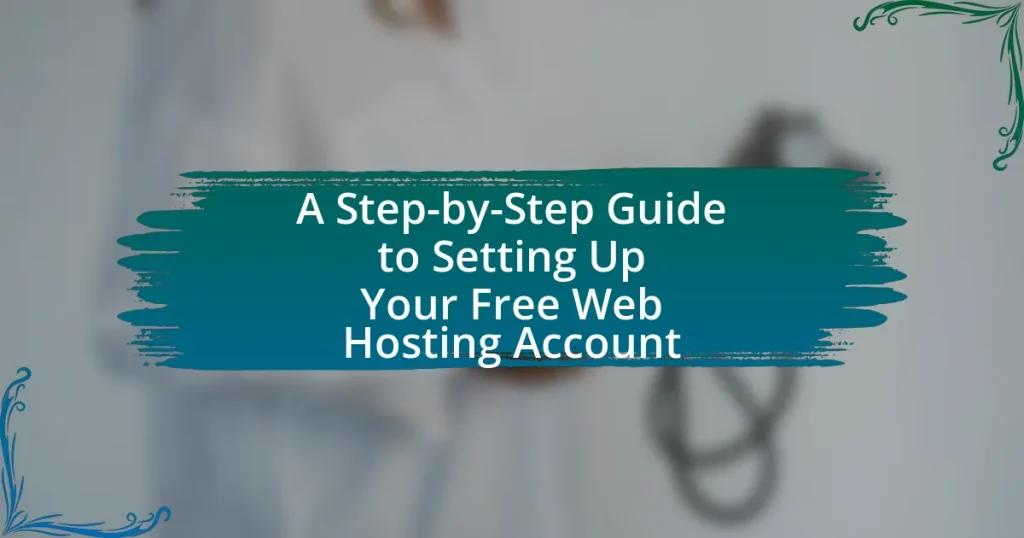A Free Web Hosting Account is a cost-effective solution for individuals and small businesses to establish an online presence without financial investment. This article provides a comprehensive guide on setting up such an account, detailing the differences between free and paid hosting options, common limitations, and essential features. It also outlines the setup process, initial configurations, best practices for management, and security measures to ensure optimal performance. Additionally, troubleshooting tips and resources for further support are included, making it a valuable resource for anyone looking to navigate the world of free web hosting effectively.

What is a Free Web Hosting Account?
A free web hosting account is a service that allows individuals or organizations to host their websites on the internet without incurring any costs. These accounts typically provide limited storage space, bandwidth, and features compared to paid hosting options. Many free web hosting providers monetize their services through advertisements displayed on hosted websites or by offering premium upgrades. According to a report by HostingAdvice, free web hosting can be a viable option for personal projects or small websites, but it often comes with restrictions that may not suit larger or commercial endeavors.
How does a Free Web Hosting Account differ from paid options?
A Free Web Hosting Account differs from paid options primarily in terms of features, resources, and support. Free accounts typically offer limited storage space, bandwidth, and fewer customization options, while paid accounts provide more extensive resources, enhanced performance, and advanced features such as custom domain names and professional email addresses. Additionally, free hosting often includes advertisements on the website and minimal customer support, whereas paid services usually offer dedicated support and a more reliable uptime guarantee. For instance, many free hosting services impose restrictions on the number of visitors or the types of applications that can be run, which can hinder website growth and functionality.
What limitations are typically associated with Free Web Hosting Accounts?
Free web hosting accounts typically have limitations such as restricted storage space, limited bandwidth, and lack of customer support. These accounts often provide minimal disk space, usually ranging from 1GB to 5GB, which can hinder the ability to host larger websites or applications. Bandwidth limitations can restrict the amount of data transferred, affecting site performance during high traffic periods. Additionally, free hosting services frequently do not offer reliable customer support, leaving users without assistance for technical issues. Furthermore, many free hosting providers display ads on user websites, which can detract from the site’s professionalism.
What features can you expect from a Free Web Hosting Account?
A Free Web Hosting Account typically offers features such as limited storage space, bandwidth, and access to basic website building tools. Users can expect a subdomain instead of a custom domain, which may include the hosting provider’s branding. Additionally, free accounts often come with limited customer support and may display ads on hosted websites. According to a survey by HostingAdvice, 70% of free hosting services impose restrictions on resources, which confirms that these limitations are common in the industry.
Why would someone choose a Free Web Hosting Account?
Someone would choose a Free Web Hosting Account primarily to minimize costs while establishing an online presence. Free web hosting services allow individuals and small businesses to create websites without financial investment, making it accessible for those with limited budgets. According to a survey by HostingAdvice, approximately 70% of new website owners opt for free hosting to test their ideas before committing to paid services. This approach enables users to evaluate the platform’s features and performance without financial risk, facilitating experimentation and learning in web development.
What are the advantages of using a Free Web Hosting Account for beginners?
Using a Free Web Hosting Account offers beginners the advantage of zero financial investment, allowing them to explore web development without incurring costs. This accessibility enables users to learn essential skills such as website design, content management, and basic coding in a risk-free environment. Additionally, many free hosting services provide user-friendly interfaces and templates, simplifying the setup process for novices. According to a survey by HostingAdvice, 70% of new website owners prefer free hosting to test their ideas before committing to paid services, highlighting its role as a practical starting point for beginners.
How can a Free Web Hosting Account benefit small businesses?
A Free Web Hosting Account can significantly benefit small businesses by providing them with a cost-effective platform to establish an online presence. This type of hosting allows small businesses to create and manage their websites without incurring initial expenses, which is crucial for startups and those with limited budgets. According to a survey by Clutch, 46% of small businesses do not have a website, often due to cost concerns; thus, free web hosting can help bridge this gap by enabling them to go online easily. Additionally, free web hosting often includes essential features such as website builders and templates, which simplify the website creation process, allowing small business owners to focus on their core operations rather than technical details.

How do you set up a Free Web Hosting Account?
To set up a free web hosting account, first, choose a reputable free web hosting provider such as InfinityFree, 000webhost, or Freehostia. After selecting a provider, visit their website and click on the sign-up or registration button. Fill out the required information, including your email address and desired password, to create an account. Once registered, verify your email if prompted, and log in to the hosting dashboard. From there, you can create a new website by selecting a domain name (often a subdomain) and uploading your website files or using a website builder provided by the host. This process is validated by the fact that many free hosting services have streamlined sign-up processes to facilitate easy access for users.
What are the initial steps to create your Free Web Hosting Account?
To create your Free Web Hosting Account, first, visit the website of a free web hosting provider. Next, locate the sign-up or registration button on the homepage. After that, fill out the required information, such as your email address and desired password, to create an account. Finally, confirm your email address through the verification link sent to your inbox to activate your account. These steps are standard across most free web hosting services, ensuring a straightforward registration process.
How do you select the right web hosting provider?
To select the right web hosting provider, evaluate key factors such as reliability, performance, customer support, pricing, and scalability. Reliability is crucial; choose a provider with a proven uptime record, ideally above 99.9%, as this ensures your website remains accessible. Performance is also important; look for hosting that offers fast loading times, which can be verified through independent speed tests. Customer support should be available 24/7 via multiple channels, including live chat and phone, to assist with any issues. Pricing should be transparent, with no hidden fees, and it’s beneficial to compare plans to find one that fits your budget while meeting your needs. Lastly, consider scalability options to accommodate future growth, ensuring the provider can support your website as it expands.
What information do you need to provide during the sign-up process?
During the sign-up process for a free web hosting account, you typically need to provide personal information such as your name, email address, and a password. Additionally, some providers may require a phone number for verification purposes. This information is essential for account creation and security, ensuring that the service can communicate with you and protect your account from unauthorized access.
What are the common configurations after setting up your account?
Common configurations after setting up your account include setting up domain names, configuring email accounts, adjusting security settings, and customizing website settings. These configurations are essential for ensuring that the web hosting account operates effectively and securely. For instance, linking a domain name allows users to access the website easily, while configuring email accounts enables communication through custom email addresses. Adjusting security settings, such as enabling SSL certificates, protects user data and enhances trust. Customizing website settings, including themes and plugins, tailors the site to meet specific needs and preferences.
How do you set up your domain name with your Free Web Hosting Account?
To set up your domain name with your Free Web Hosting Account, first, log into your web hosting control panel. Next, locate the domain management section, where you can either register a new domain or link an existing one. If you are linking an existing domain, update the domain’s nameservers to those provided by your hosting service. This process typically involves entering the nameserver addresses into your domain registrar’s settings. After saving the changes, allow up to 48 hours for DNS propagation. This method is standard across many free web hosting services, ensuring that your domain points correctly to your hosting account.
What are the essential settings to configure for optimal performance?
To achieve optimal performance in a free web hosting account, essential settings include enabling caching, optimizing database configurations, and setting up a content delivery network (CDN). Caching reduces load times by storing frequently accessed data, while optimizing database configurations, such as adjusting connection limits and query caching, enhances data retrieval efficiency. Implementing a CDN distributes content across multiple servers, improving access speed for users globally. These configurations are supported by studies indicating that optimized caching can reduce load times by up to 70%, and CDNs can improve site speed by 50% or more, thereby enhancing user experience and site performance.

What are the best practices for managing your Free Web Hosting Account?
The best practices for managing your Free Web Hosting Account include regularly monitoring your account for uptime and performance, ensuring you back up your data frequently, and keeping your website content updated. Regular monitoring helps identify issues early, as studies show that websites with consistent uptime can improve user engagement by up to 50%. Frequent backups protect against data loss, with 30% of users experiencing data loss due to server failures or hacking. Updating content not only enhances user experience but also improves search engine rankings, as search engines favor fresh content.
How can you ensure your website remains secure on a Free Web Hosting Account?
To ensure your website remains secure on a Free Web Hosting Account, implement strong passwords and regularly update them. Strong passwords reduce the risk of unauthorized access, and regular updates help mitigate potential vulnerabilities. Additionally, utilize SSL certificates to encrypt data transmitted between the server and users, enhancing security. Regularly back up your website data to prevent loss in case of a security breach. Employ security plugins or tools that monitor for malware and vulnerabilities, as these can provide real-time protection and alerts. Lastly, keep all software, including content management systems and plugins, up to date to protect against known security flaws.
What security measures should you implement?
Implement strong security measures such as using SSL certificates, enabling two-factor authentication, and regularly updating software. SSL certificates encrypt data transmitted between the user and the server, protecting sensitive information from interception. Two-factor authentication adds an extra layer of security by requiring a second form of verification, significantly reducing the risk of unauthorized access. Regular software updates patch vulnerabilities, ensuring that your web hosting environment remains secure against emerging threats. These measures collectively enhance the overall security posture of your web hosting account.
How can you back up your website data effectively?
To back up your website data effectively, utilize automated backup solutions provided by your web hosting service or third-party tools. Automated backups ensure that your data is regularly saved without manual intervention, reducing the risk of data loss. For instance, many hosting providers offer daily backups as part of their service, which can be restored easily if needed. Additionally, using plugins or software like UpdraftPlus for WordPress can facilitate scheduled backups to cloud storage services such as Google Drive or Dropbox, ensuring that your data is secure and accessible. Regularly verifying the integrity of your backups is also crucial, as it confirms that the data can be restored successfully when required.
What troubleshooting tips can help you with your Free Web Hosting Account?
To troubleshoot issues with your Free Web Hosting Account, first check your internet connection to ensure it is stable and functioning. If the connection is fine, verify that your domain name is correctly pointed to the hosting server by checking the DNS settings. Additionally, clear your browser cache and cookies, as this can resolve loading issues. If you encounter error messages, consult the hosting provider’s documentation or support for specific error codes, as they often provide solutions tailored to common problems. Regularly updating your website’s software and plugins can also prevent compatibility issues that may arise.
How do you resolve common issues faced by Free Web Hosting users?
To resolve common issues faced by Free Web Hosting users, first, identify the specific problem, such as slow loading times, limited storage, or downtime. For slow loading times, users can optimize their website by compressing images and minimizing code. Limited storage can be addressed by regularly deleting unnecessary files or upgrading to a paid plan if needed. Downtime issues can often be mitigated by checking server status and contacting customer support for assistance. According to a 2021 survey by HostingAdvice, 70% of users reported that timely customer support significantly improved their experience with free hosting services.
What resources are available for additional support?
For additional support in setting up your free web hosting account, users can access online forums, customer support services, and comprehensive documentation provided by hosting companies. Online forums, such as Stack Overflow, offer community-driven assistance where users can ask questions and share experiences. Customer support services typically include live chat, email, or phone support, ensuring direct help from hosting providers. Comprehensive documentation often includes FAQs, setup guides, and troubleshooting tips, which are essential for resolving common issues encountered during the setup process.
What are the key takeaways for successfully using a Free Web Hosting Account?
To successfully use a Free Web Hosting Account, prioritize understanding the limitations and features of the service. Free web hosting often comes with restrictions such as limited bandwidth, storage, and customer support, which can impact website performance and reliability. For instance, many free hosting providers display ads on your site, which can detract from user experience. Additionally, ensure you regularly back up your data, as free services may not offer robust backup solutions. Familiarize yourself with the hosting provider’s terms of service to avoid unexpected issues, such as account suspension due to resource overuse. Lastly, consider upgrading to a paid plan if your website grows, as this can provide better performance and additional features.


